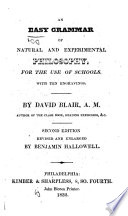 | Sir Richard Phillips - Physics - 1832 - 286 pages
...will pass by it, and if he move his hand to one side, the hand of the image will move to the other. A by-stander will see nothing of the image, because none of the reflected rays can enter his eyes. Observation. There are many deceptions on the same principle ; as the magic flower... | |
 | Francis Lieber, Edward Wigglesworth - Encyclopedias and dictionaries - 1835 - 620 pages
...side, the hand of the image will move towards the other ; so that, whatever way the object moves, th« image will move the contrary way. A bystander will...of the reflected rays that form it enter his eyes. The images formed by convex specula are in positions similar to those of their objects; and those also... | |
 | Sir Daniel Keyte Sandford - Art - 1837 - 528 pages
...towards the other; so that, whatever way the object moves, the image will move tlie contrary way. Л bystander will see nothing of the image, because none of the reflected rays tliat form it enter his eyes. The images formed by convex specula are in positions similar to those... | |
 | Thomas Dick - 1845 - 608 pages
...image moving always in a contrary direction to the object. All this while the by-standers, if any, see nothing of the image, because none of the reflected rays that form it can enter their eyes. — The following figure represents a phenomenon produced in the same manner.... | |
 | Thomas Dick - Astronomical instruments - 1845 - 644 pages
...image moving always in a contrary direction to the object. All this while the by-standers, if any, see nothing of the image, because none of the reflected rays that form it can enter their eyes, — The following figure represents a phenomenon produced in the same manner.... | |
 | Popular encyclopedia - 1846 - 1018 pages
...if he move his hand towards either side, the hand of the image will move towards the other; so that, whatever way the object moves, the image will move the contrary way. Л bystander will see nothing of the image, because none of the reflected rays that form it enter his... | |
 | Mrs. Lincoln Phelps - Physics - 1848 - 330 pages
...if he move his hand towards either side, the hand of the image will move towards the other, so that whatever way the object moves, the image will move the contrary way. This appearance of the image in the air between the mirror and the object, has been productive of many... | |
 | Thomas Dick - Educational sociology - 1850 - 586 pages
...the image moving always in a contrary direction to the object. All this while the bystanders, if any, see nothing of the image, because none of the reflected rays that form it can enter their eyes. The following figure represents a phenomenon produced in the Fig. 25. same manner,... | |
 | Francis Lieber - Encyclopedias and dictionaries - 1851 - 618 pages
...he move his hand towards either side, the hand of the image will move towards the other ; so that, whatever way the object moves, the image will move...of the reflected rays that form it enter his eyes. The images form ed by convex specula are in positions similar to those of their objects ; and those... | |
 | John Henry Pepper - Science - 1860 - 474 pages
...only. Whilst experimenting with a concave mirror, by holding out the hand iu the manner described, a bystander will see nothing of the image, because...of the reflected rays that form it enter his eyes. This circumstance is well illustrated by placing a concave mirror opposite the fire, and allowing the... | |
| |